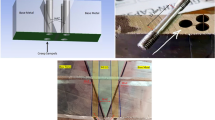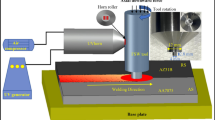Abstract
Hot cracking studies on autogenous AA2014 T6 TIG welds were carried out. Significant cracking was observed during linear and circular welding test (CWT) on 4-mm-thick plates. Weld metal grain structure and amount of liquid distribution during the terminal stages of solidification were the key cause for hot cracking in aluminum welds. Square-wave AC TIG welding with transverse mechanical arc oscillation (TMAO) was employed to study the cracking behavior during linear and CWT. TMAO welds with amplitude = 0.9 mm and frequency = 0.5 Hz showed significant reduction in cracking tendency. The increase in cracking resistance in the arc-oscillated weld was attributed to grain refinement and improved weld bead morphology, which improved the weld metal ductility and uniformity, respectively, of residual tensile stresses that developed during welding. The obtained results were comparable to those of reported favorable results of electromagnetic arc oscillation.














Similar content being viewed by others
References
P.O. Puzak, W.R. Apblett, and W.S. Pellini: Weld. J., 1956, vol. 35 (1), pp. 9–20.
J.E. Steenbergen and H.R. Thornton: Weld. J., 1970, vol. 49 (2), pp. 61s–68s.
F.C. Hull: Weld. J., 1967, vol. 46 (9), pp. 399s–409s.
C.E. Cross: Hot Cracking Phenomena in Welds, Springer, New York, NY, 2005, pp. 3–18.
M. Miyazaki, K. Nishio, M. Katoh, S. Mukae, and H.W. Kerr: Weld. J., 1990, vol. 69 (9), pp. 362s–71s.
S. Kou: JOM, 2003, vol. 6, pp. 37–42.
G.J. Davies and J.G. Garland: Int. Met. Rev., 1975, vol. 20, pp. 85–105.
A.R.E. Singer and P.H.J. Jennings: Inst. Met., 1947, vol. 73, pp. 273–84.
J.L. Robinson and M.H. Scott: Phil. Trans. R. Soc. London, 1980, vol. A285, pp. 105–17.
C. Huang and S. Kou: Weld. J., 2004, vol. 83 (2), pp. 50–58.
J.C. Lippold: Hot Cracking Phenomena in Welds, Springer-Verlag, Berlin, Germany, 2005, pp. 271–90.
J.C.M. Farrar: Hot Cracking Phenomena in Welds, Springer, New York, NY, 2005, pp. 291–304.
H. Heuser: Hot Cracking Phenomena in Welds, Springer, New York, NY, 2005, pp. 305–27.
E. Cical˘a, G. Duffet, H. Andrzejewski, D. Grevey, and S. Ignata: Mater. Sci. Eng. A, 2005, vol. 395, pp. 1–9.
G.M. Goodwin: “Test Methods for Evaluating Hot Cracking: Review and Perspectives,” Energy Citation Database, Science Accelerator, OTSI, US Department of Energy, 1990, pp. 1–26.
T.W. Nelson, J.C. Lippold, W. Lin, and W.A. Baeslack III: Weld. J., 1997, vol. 76 (3), pp. 110–19.
S. Kou: Welding Metallurgy, 2nd ed., John Wiley and Sons, New York, NY, 2003, pp. 321–24.
H. Yunjia, R.H. Frost, D.L. Olson, and G.R. Edwards: Weld. J., 1989, vol. 68, pp. 280–88.
M.J. Dvornak, R.H. Frost, and D.L. Olson: Weld. J., 1989, vol. 68, p. 327s.
V. Balasubramanian, V. Ravisankar, and G. Madhusudhan Reddy: Mater. Sci. Eng. A, 2007, vol. 2459, pp. 19–34.
Y.M. Zhang, C. Pan, and A.T. Male: Metall. Mater. Trans. A, 2000, vol. 31A, pp. 2537–43.
J.C. Villafuerte and H.W. Kerr: Weld. J., 1990, vol. 69, pp. 1s–13s.
S.P. Tewari: Thammasat Int. J. Sci. Technol., 2009, vol. 14 (4), pp. 17–27.
S. Kou and Y. Le: Weld. J., 1986, vol. 65 (12), pp. 305–13s.
S. Kou and Y. Le: Metall. Trans. A, 1985, vol. 16A, pp. 1345–52.
S. Kou and Y. Le: Weld. J., 1985, vol. 64 (3), pp. 51s–55s.
S. Sundaresan and G.D. Janakiram: Sci. Technol. Weld. Join., 1999, vol. 4, pp. 151–61.
C.-F. Tseng and W.F. Savage: Weld. J., 1971, vol. 51 (11), pp. 777–85.
S.R. Koteswara Rao, G.M. Reddy, M. Kamaraj, and K. Prasad Rao: Mater. Sci. Eng. A, 2005, vol. 404, pp. 227–34.
J.G. Garland: Met. Construct., Br. Weld. J., 1974, vol. 55 (4), pp. 121–27.
TIG Welding Handbook, Miller Electric Mfg. Co., Appleton, pp. 5–18.
Ador Welding Limited: Modern Welding, Oxford and IBH Publishing Co. Pvt. Ltd., New Delhi, 2005, pp. 275–78.
Operational Manual MO-150 Mechanical Oscillator, Jetline Engineering Inc., Irvine, CA, pp. 5–38.
A. Kumar, P. Shailesh, and S. Sundarrajan: Mater. Des., 2008, vol. 29, pp. 1904–13.
N.S. Biradar, S. Mishra, and R. Raman: Materials Research Symp.-MR-10, IIT Bombay, Bombay, 2010, pp. 72–73.
J.H. Dudas and F.R. Collins: Weld. J., 1966, vol. 45, pp. 241s–49s.
T.-L. Teng, P.-H. Chang, and H.-C. Ko: Int. J. Pressure Vess. Pip., 2000, vol. 77, pp. 643–50.
N.S. Biradar and R. Raman: Proc. IIW Int. Conf. on Joining, Cutting, and Surfacing Technology, D.V. Kulkarni, Manish Samant, S. Krishnan, Amitava De, J. Krishnan, H. Patel, and A.K. Bhaduri, eds., Chennai, 2011, pp. 371–79.
ASM Specialty Handbook: Aluminum and Aluminum Alloys, J.R. Davis, ed., ASM INTERNATIONAL, Materials Park, OH, 1994, pp. 376–419.
J.A. Brooks and J.J. Dike: Proc. 5th Int. Conf. on International Trends in Welding Research, Pine Mountain, GA, June 1998, ASM INTERNATIONAL, Materials Park, OH, 1999, pp. 695–99.
D.M. Douglass, J. Mazumder, and K. Nagarathnam: Proc. 4th Int. Conf. on Trends in Welding Research, Gatlinburg, TN, June 1995, pp. 467–78.
K. Easterling: Introduction to Physical Metallurgy of Welding, Butterworth and Co. Ltd., Mosco, 1983, pp. 55–66.
L.F. Mondolfo: Aluminum Alloys Structure and Properties, Butterworth and Co., London, 1976, pp. 693–700.
M.C. Flemings: Solidification Processing, McGraw-Hill, New York, NY, 1974, pp. 73–83.
R.W. Messler, Jr.: Principles of Welding, John Wiley and Sons, Inc., New York, NY, 1999, pp. 175–76.
Acknowledgments
The authors thank the Indian Space Research Organization (ISRO, Trivandrum, India) for providing the material AA2014 aluminum alloy in the T6 condition necessary for carrying out the experiments in the research study.
Author information
Authors and Affiliations
Corresponding author
Additional information
Manuscript submitted October 13, 2011.
Appendices
Appendix: Calculation of effective welding speed (w)
where u = linear welding speed (3.6 mm/s for linear welding and 5.3 mm/s for CWT welding) and v = transverse welding speed of the torch in mm/s. Effective welding speed for the TMAO parameter (amplitude = 0.9 mm and frequency = 0.5 Hz):
Heat input calculations (H Net) used for tungsten inert gas welding with and without TMAO (amplitude = 0.9 mm and frequency = 0.5 Hz)
For linear TIG welding:
For CWT TIG welding:
where V = voltage in volts, I = current in Amps, η = arc efficiency (assumed as 0.40 for TIG),[32] u = welding speed in mm/s (without arc oscillation), and w = effective welding speed due to TMAO in mm/s.
Cooling rate calculations, R, for TIG welds without and with TMAO (amplitude = 0.9 mm and frequency = 0.5 Hz)
For Linear TIG welding:
R = 2πkρC (τ/H Net)2 (T c – T 0)3 for thin plates at full penetration were produced.[45]
For CWT TIG welds:
where k = thermal conductivity (J/mm2 K), ρC = thermal capacity (J/mm3 K), τ = thickness of the plate (mm), H Net = effective heat input (J/mm), T c = liquidus temperature (K), and T 0 = initial temperature (K).
Rights and permissions
About this article
Cite this article
Biradar, N.S., Raman, R. Investigation of Hot Cracking Behavior in Transverse Mechanically Arc Oscillated Autogenous AA2014 T6 TIG Welds. Metall Mater Trans A 43, 3179–3191 (2012). https://doi.org/10.1007/s11661-012-1126-4
Published:
Issue Date:
DOI: https://doi.org/10.1007/s11661-012-1126-4




